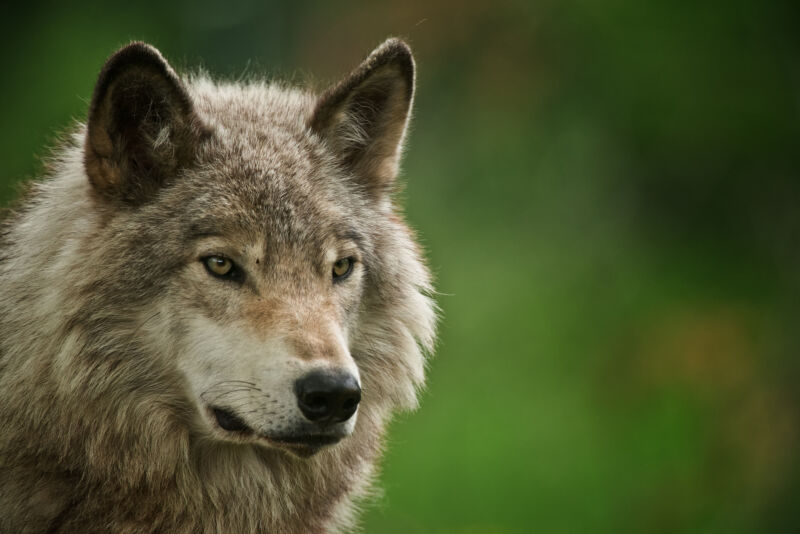Man's best friend was the first of many animals humans have domesticated. But there was no clear before-and-after moment where dogs were suddenly a distinct population of wolves. While some ancient skeletons are clearly dogs, there are a lot of ambiguous skeletons earlier than that. It's possible to get a sense of what happened using the genomes of modern and ancient dogs. But this analysis depends heavily on what you think the wolf populations dogs were derived from look like.
Now, researchers have generated a much clearer picture of the last 100,000 years of wolf evolution. The picture it paints is a population that remained a single unit despite being spread across continents in the Arctic, with the population sporadically refreshed from a core centered in Siberia. Many breeds of dogs seem to have been derived from a population of East Asian wolves. But others seem to have also received significant input from a Middle East population—but it's unclear whether that population was wolves or dogs.
Wolves around the north
The ability to sequence ancient DNA was essential to this new work, which involved obtaining DNA from 66 wolf skeletons that collectively span about 100,000 years of evolution, including most of the last ice age. Wolves are found in the Northern Hemisphere, and the skeletons used here tend to be closer to the Arctic (probably in part because DNA survives better in cooler climes). But they are widely distributed, with Europe, Asia, and North America represented. The researchers also included five ancient wolf genomes that others had analyzed, along with some genomes of modern wolves.
Typically, you'd expect to find regional populations that don't often intermingle with their more distant relations. If you map out the most closely related genomes, you'll typically find they cluster together. That's not the case here; instead, the ancient wolf genomes clustered together in time. That is, a given wolf was most likely to be closely related to other wolves alive at around the same time, no matter where those wolves lived on the planet.
Studies of modern wolves indicated that local populations developed after the final peak of the last glacial period. But all of these populations are more similar to each other than the wolves around before the ice age's peak.
How did these animals retain genetic continuity over the huge distances that separated them? Apparently, by repeated expansions of the population in Siberia. There was a distinct European wolf population somewhere before 100,000 years ago. But continued arrivals from Siberia gradually reduced the ancestral European presence to anywhere between 10 and 40 percent, depending on the animal. In North America, in contrast, all present-day wolves are primarily derived from Siberia, with the rest a contribution from interbreeding with coyotes.
One consequence of having a global population is that favorable mutations spread rapidly worldwide. The researchers found 24 areas of the genome that appear to carry useful adaptations, and all of these useful stretches of DNA show up in all of the wolf populations examined.
Gone to the dogs
So, what can we say about dogs? They also look like the Siberian wolves that were alive just before the last peak of the ice age. But when every wolf older than that point was tested for a close relationship with dogs, the connection wasn't robust. That suggests that if dogs were derived from a specific wolf population, we don't have DNA from that population.
But the researchers found that there's a good match if you had a population that was mostly Siberian wolf with a fraction of its DNA (between 10 and 20 percent) coming from a different canid, the dhole, which is also found in Asia. Some breeds of dogs in East Asia appear to have retained this ancestry to the present day.
But other breeds in Europe and Africa seem to have a large contribution from a wolf population that's most closely related to a present-day wolf from Syria. The researchers estimate that a Mideastern dog from about 7,500 years ago had about half its genome from this local source and half from Siberian ancestors. Many dogs in Africa and Europe have anywhere from 20 to 60 percent of their genomes from this additional ancestor.
Overall, their data favors a model where dogs were first domesticated in Eastern Asia, where most of the breeds present are derived solely from Siberian ancestors. But as our best friend spread around Asia with us, it came into contact with another population, likely near the Middle East. That population could have been wolves, could have been a dog population that had been domesticated separately, or it could have been somewhere between the two—there's no way to tell with genetic data.
In any case, the wolf data provides some context on why the ancestry of dogs has been so challenging to sort out: Genetically, wolves are unusual in having a global population that's regularly churned up in a way that disrupts stable, long-term regional populations. One consequence of this is that there's not much point in looking for a wolf population that dogs are tightly related to as a way to identify where dogs were domesticated. Even if that wolf population existed at the time, it would likely end up mixing with other populations shortly after.
Nature, 2022. DOI: 10.1038/s41586-022-04824-9 (About DOIs).



3175x175(CURRENT).thumb.jpg.b05acc060982b36f5891ba728e6d953c.jpg)

Recommended Comments
There are no comments to display.
Join the conversation
You can post now and register later. If you have an account, sign in now to post with your account.
Note: Your post will require moderator approval before it will be visible.